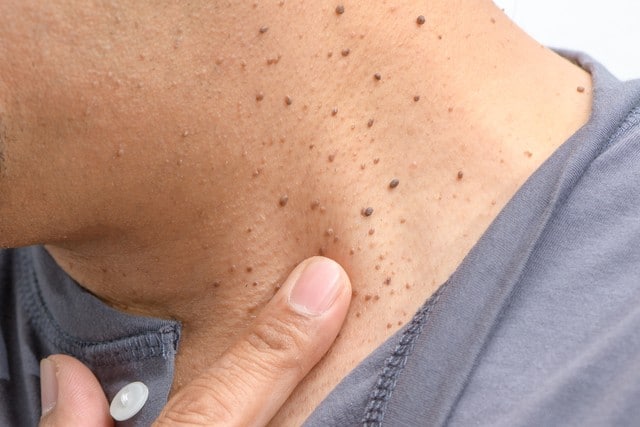Skin tags are small, soft, and benign growths that occur on the skin’s surface. They are typically harmless and painless but can be unsightly and irritating, especially when they appear on the neck. Skin tags on the neck are common and can be caused by various factors.
Friction is one of the most common causes of skin tags on the neck. When skin rubs against skin, clothing, or jewellery, it can cause skin tags to form. This is especially true in areas with folds of skin, such as the neck. People who are overweight or have excess skin are more likely to develop skin tags due to friction.
Another factor that can contribute to skin tags on the neck is genetics. Some people are more prone to developing skin tags than others. The risk of developing skin tags can also increase due to hormonal changes, like during menopause or pregnancy, can also increase the risk of developing skin tags. Certain medical conditions, such as diabetes and obesity, may also increase the risk of developing skin tags.
What are Skin Tags on the Neck?
Skin tags, also known as acrochordons, are small, soft, benign growths that hang off the skin. They are common and harmless and can appear on various body parts, including the neck. They often resemble a small, soft, balloon-like bump attached to the skin by a thin stalk. Skin tags can vary in size and colour but are typically flesh-coloured or slightly darker than the surrounding skin.
While skin tags can appear on anyone, they are more common in middle-aged and elderly individuals. They are also more likely to occur where skin rubs against skin, such as the neck, underarms, and groin. Skin tags are not contagious and are not caused by poor hygiene or lack of cleanliness.
Although skin tags are usually harmless, they can sometimes become irritated or inflamed, which can cause discomfort or pain. In rare cases, they can also bleed or become infected. If a skin tag is causing discomfort or concern, it is recommended to consult a healthcare professional for evaluation and treatment options.
Causes of Skin Tags on Neck
Skin tags on the neck are small, soft, and fleshy growths that appear on the skin. They are usually harmless and painless but can be a cosmetic concern for some people. The exact cause of skin tags is unknown, but several factors may contribute to their development.
Friction
Friction is one of the most common causes of skin tags on the neck. When skin rubs against skin, clothing, or jewellery, it can create a frictional force that can cause skin tags to form. This is why skin tags are more common in areas of the body where skin rubs against skin, such as the neck, armpits, and groin.
Age
Another factor that may contribute to developing skin tags on the neck is age. Skin tags are more common in middle-aged and older adults and the risk of developing them increases. This may be due to changes in hormone levels, genetics, or other factors as we age.
Obesity
Obesity is also a risk factor for skin tags on the neck. People who are overweight or obese are more likely to develop skin tags, particularly in areas where skin rubs against the skin. This is because excess body fat can create a more frictional force on the skin, leading to the development of skin tags.
Pregnancy
Pregnancy can also increase the risk of developing skin tags on the neck. Hormonal changes during pregnancy can cause the skin to become more sensitive and prone to irritation, which can lead to the development of skin tags.
Diabetes
People with diabetes are also more likely to develop skin tags on the neck. This may be due to changes in insulin levels or other factors associated with diabetes. Skin tags may also be a sign of insulin resistance, which is a common complication of diabetes.
Heredity
Heredity may also play a role in developing skin tags on the neck. People with a family history of skin tags are more likely to develop them themselves. This suggests that there may be a genetic component to developing skin tags.

Risk Factors for Skin Tags on Neck
Skin tags are benign growths that can appear on any part of the body but are most commonly found on the neck. While skin tags are harmless, they can be unsightly and cause discomfort if they rub against clothing or jewellery. Several risk factors can increase the likelihood of developing skin tags on the neck.
One of the most common risk factors for skin tags on the neck is age. As people age, their skin becomes looser and more prone to developing skin tags. Hormonal changes during pregnancy can also increase the likelihood of developing skin tags, particularly on the neck.
Obesity is another risk factor for skin tags on the neck. People who are overweight or obese are more likely to develop skin tags due to the increased friction between skin folds. In addition, people with type 2 diabetes are more likely to develop skin tags on the neck and other body parts.
Finally, genetics may play a role in developing skin tags on the neck. People with a family history of skin tags are more likely to develop them themselves. However, more research is needed to understand the genetic factors contributing to skin tag development fully.
Prevention of Skin Tags on Neck
Although skin tags on the neck are common and usually harmless, they can be unsightly and bothersome. Fortunately, some steps can be taken to prevent them from occurring:
- Keep the neck area clean and dry, as moisture can contribute to the formation of skin tags.
- Avoid wearing tight clothing or jewellery that rubs against the neck, as friction can irritate the skin and lead to the development of skin tags.
- Maintain a healthy weight, as excess weight can increase the likelihood of developing skin tags.
- Avoid using harsh chemicals or products on the neck area, as these can irritate the skin and lead to the formation of skin tags.
- Consider using natural remedies, such as tea tree oil or apple cider vinegar, which may help prevent skin tags from forming.
While these measures may not guarantee that skin tags will not develop, they can certainly reduce the risk of their occurrence. If skin tags do appear, it is essential to remember that they are usually harmless and can be easily removed by a dermatologist.
When to See a Doctor
If a skin tag on the neck is causing discomfort or bleeding, it is essential to see a doctor. Additionally, if a skin tag appears to be changing in size, shape, or colour, it is recommended to seek medical attention. This could be a sign of a more severe skin condition.
Individuals with a family history of skin cancer or other skin conditions should also consult a doctor if they notice a skin tag on their necks.
The skin tag may be examined during a doctor’s visit, and a biopsy may be performed to rule out any underlying health concerns. If the skin tag is harmless, the doctor may recommend a removal procedure.
Conclusion
Skin tags on the neck are a common occurrence and can be caused by various factors. While they are generally harmless, they can be unsightly and uncomfortable for some people. It is essential to understand the underlying causes of skin tags to prevent them from occurring or to treat them effectively.
Some of the most common causes of skin tags on the neck include friction, hormonal changes, genetics, and obesity. People who are overweight or obese are more likely to develop skin tags due to the increased friction and moisture in the skin folds. Hormonal changes during pregnancy and menopause can also cause skin tags to develop. While there is no guaranteed way to prevent skin tags from occurring, maintaining a healthy weight and practising good hygiene can help reduce the risk.
In addition, treating underlying medical conditions such as diabetes and thyroid disorders can also help prevent skin tags from forming. Overall, skin tags on the neck are common and generally harmless. By understanding the underlying causes and taking steps to prevent them from occurring, individuals can reduce the likelihood of developing skin tags and improve their overall skin health.
Also Read:
How To Get Super Glue Off Skin?





















